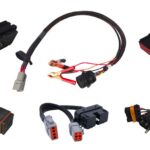The Caterpillar 3406 A Cat engine is a powerful and reliable workhorse known for its durability and longevity. Commonly found in heavy-duty applications like on-highway trucks, marine vessels, and industrial equipment, the 3406 A CAT delivers robust performance. This article delves into the common problems, troubleshooting tips, and replacement options for the 3406 A CAT engine.
Common 3406 A CAT Engine Problems
While renowned for its robustness, the 3406 A CAT isn’t immune to issues. Understanding these potential problems can help owners address them proactively and minimize downtime. Some frequent problems include:
- Spun Crankshaft Bearings: This critical failure can lead to catastrophic engine damage and requires immediate attention.
- Cracked Cylinder Head: Often caused by overheating or excessive pressure, a cracked cylinder head can result in coolant leaks and compression loss.
- Scored Pistons and Liners: Excessive heat and inadequate lubrication can score pistons and liners, impacting engine performance and efficiency.
- Overfueling: This can lead to excessive soot buildup, decreased fuel economy, and potential engine damage.
- Oil Pressure Issues: Insufficient oil pressure can starve the engine of lubrication, leading to rapid wear and tear.
- Camshaft Failure: A worn or broken camshaft can disrupt valve timing and significantly impact engine performance.
- Dropped Valves: This serious issue can cause extensive internal damage and requires immediate engine repair.
Troubleshooting 3406 A CAT Engine Problems
Addressing 3406 A CAT engine problems often requires a systematic approach:
- Regular Maintenance: Adhering to a strict maintenance schedule, including oil changes, filter replacements, and coolant checks, is crucial for preventing many common issues.
- Diagnostics: Utilizing diagnostic tools can help pinpoint the root cause of problems and guide repair efforts.
- Visual Inspection: Regularly inspecting the engine for leaks, unusual noises, and excessive smoke can provide early warning signs of potential problems.
3406 A CAT Engine Replacement Options: Remanufactured Engines
When faced with extensive engine damage or wear, a remanufactured 3406 A CAT engine offers a cost-effective and reliable solution. Remanufacturing involves a comprehensive process that restores the engine to its original specifications:
The Remanufacturing Process:
- Thorough Cleaning: The engine is completely disassembled and cleaned to remove all debris and contaminants.
- Crankshaft Inspection and Machining: The crankshaft is inspected for cracks and damage, then machined to precise tolerances.
- Cylinder Head Reconditioning: The cylinder head is resurfaced, pressure tested, and valves are inspected and replaced as needed.
- Block Inspection and Machining: The engine block is inspected for cracks and damage, and cylinders are bored and honed.
- Camshaft Inspection: The camshaft is inspected for wear and tear and replaced if necessary.
- Connecting Rods Reconditioning: Connecting rods are inspected, resized, and fitted with new bushings.
- New Parts: Remanufactured engines typically include new pistons, rings, bearings, gaskets, and seals.
Conclusion
The 3406 A CAT engine is a powerful and reliable engine, but like any mechanical system, it can experience problems. Understanding these common issues and utilizing proper troubleshooting techniques can help extend the engine’s life. When major repairs are needed, a remanufactured 3406 A CAT engine offers a cost-effective solution that delivers like-new performance and reliability. Regular maintenance and proactive problem-solving are key to maximizing the lifespan and performance of this workhorse engine.
